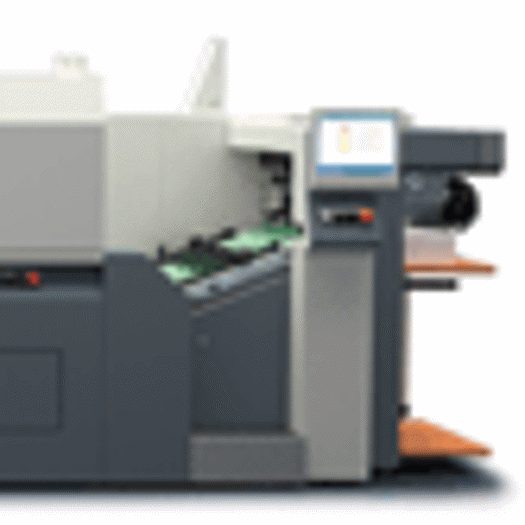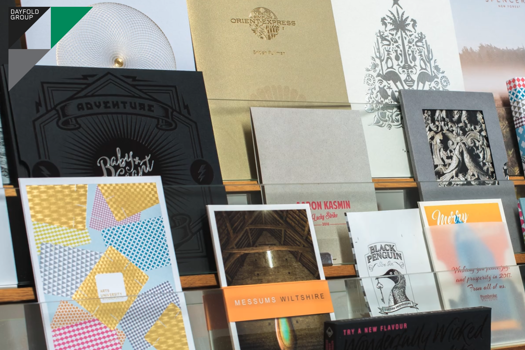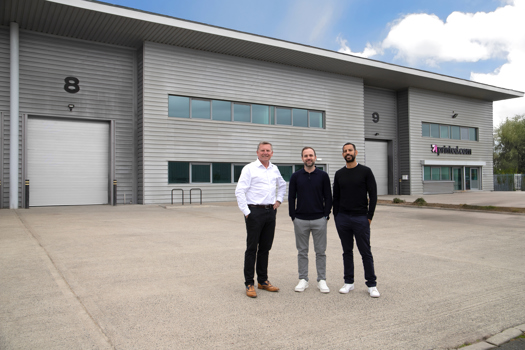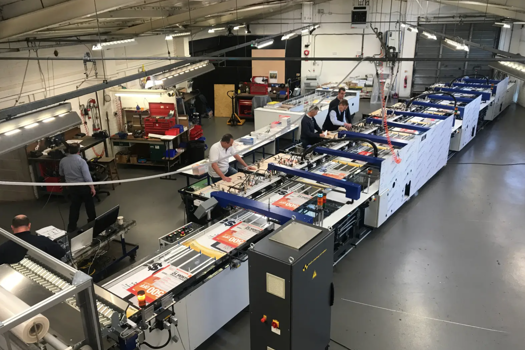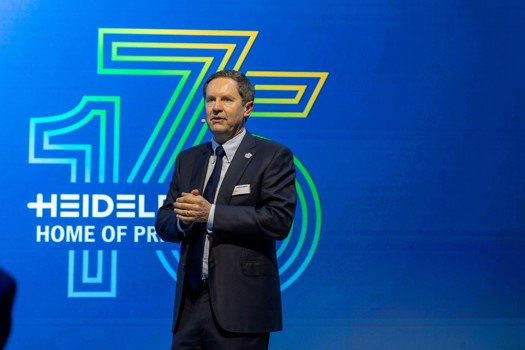Click here to return to the Technology report contents page
Ladies and gentlemen, welcome to the big fight. The venue is Birmingham's NEC; the event, Ipex. And now, please welcome to the arena, the contenders. In the red corner, the reigning champion, the tried and tested, long-time title-holder and - many would maintain - still the superior force in every way (in spite of its age): B2 offset. And in the blue corner, the upstart challenger, the technological titan, the digital destroyer: B2 inkjet. Seconds out. Round one.
Ipex 2010 will play host to one of the most fiercely contested technology battles of recent years; the comparatively young, but rapidly maturing B2 inkjet will be pitted against the might of B2 offset. It's a case of youth versus experience, but the outcome is far from clear. Many claim that B2 inkjet will revolutionise the printing industry, but is it really a ‘game-changing' technology and, more importantly, in this fight can there truly only be one winner?
Makeready to rumble
One manufacturer that is well-and-truly behind the B2 inkjet movement is Fujifilm. At Ipex, the company will give a commercial launch to its Jet Press 720 B2 sheetfed inkjet platform. Fujifilm is pitching its new 2,700-sheet-per-hour press, initially at least, at the short-run commercial operators.
According to Fujifilm Graphic Systems director Keith Dalton, in this field at least, "makeready is key", a point that is picked up by Graham Leeson, marketing manager for the firm, who says that, currently, between 40% and 70% of B2 jobs are less than 2,000 sheets. In these circumstances, makeready time plays a key role in ensuring profitability. But the advantages go further than that; Dalton says that by reducing makereadies, the Jet Press 720 can cut paper waste by as much as 50%, while its carbon footprint is said to be around 25% smaller than that of a "typical" offset press, both of which will boost a printer's green credentials.
"The majority of the market is 500-2,000 sheets, which is where the opportunity for the Jet Press is. If you're doing that sort of work on an offset press designed for jobs of 2,000 and up, you're immediately uncompetitive," adds Dalton. Fuji also says that running the press in a commercial print operation could halve the production time of a 1,000-run 32pp brochure compared to a litho alternative.
So, this new kid on the block is no slouch. Digital has some impressive footwork and the ability to land some decent blows, but offset is showing no signs of weakening yet. Neil Handforth, director of sales and marketing of the Ryobi division at Apex Digital Graphics, argues that digital's shorter makereadies are "negated" when offset machines, such as the Ryobi 750 series and its semi automatic plate changing, allow for a "very effective and efficient turnaround times" on jobs.
"There could be a slight gap in the market for the shorter-run jobs these machines can handle, but you're going to need a lot of work to fill these presses. Game-changing technology? I don't agree with that," says Handforth, aiming a litho jab at digital's solar plexus.
At Ipex, Fujifilm will be showcasing a simplex B2 four-colour configuration, but Dalton stresses that there is much more to come from the Jet Press platform. "The technology is capable of duplex, more than four colours and wider formats than B2, but we want to walk before we can run. Who knows what else will come?"
What's pushing the digital manufacturers onto the back foot is uncertainty over the pricing structures for these flexible machines. Fujifilm has said that the Jet Press 720 will retail for around $1m (£640,000), but Dalton stresses that the cost should reflect the total cost of ownership. "We'll sell it how customers ask for it. Our idea is that it won't be on a click charge, but on a conventional model," he says.
Christian Knapp, managing director of KBA UK, is unconvinced. "You can charge up front, but allow the customer to make their choices following that. Alternatively, you can offer a low up-front investment and then tie people in afterwards. I don't think you can do both. Customers don't want to be tied in and tied down," he says.
At Ipex, KBA will champion its latest sheetfed offset presses with Knapp calling the show a "critical" event for the industry. On display will be the Rapida 75, 105 and 106 presses, and the B3 five-colour Genius UV press. And while the manufacturer will be championing its own press technology, Knapp is making conciliatory noises by saying that B2 inkjet and B2 offset can work in harmony. "They can co-exist and they will co-exist," he says. "The answer really comes down to the type of application that you want to fulfil and how you want to approach it. For personalised, digitally printed documents, B2 inkjet is a way to do that economically while litho is better if you want a higher-quality document printed on a broader variety of substrates," adds Knapp.
One key technology KBA will be showcasing at Ipex is Flying JobChange feature of its 18,000sph Rapida 106 that allows for parallel printing and makeready and results in non-stop job changeovers, according to the manufacturer. The press configuration at the show will include KBA's DriveTronic SPC dedicated plate-cylinder drives for simultaneous plate changing. And, according to Knapp, by reducing makeready, the company can further eat into the shorter-run, quick-turnaround market being targeted by machines such as the Jet Press and Screen's Truepress.
Evenly matched
Knapp believes that Ipex will prove to be a good indicator for where the market is going. "Inkjet has taken a long while to mature and it will be interesting to see how platforms do. The show is a good barometer. Ipex comes at a good time and hopefully confidence and finance will return in time. I'm hopeful that the Ipex impetus will bring back confidence to the marketplace," he says.
Andrew Tribute, a PrintWeek columnist and consultant in digital and pre-press technology, is far from convinced that such presses have a space in a market already served by B3 digital and B2 offset. According to Tribute, the main hurdle to selling a product pitched as a short-run press, and that may not be ideal for variable data, is that these machines already exist. He says: "Offset, particularly where the same inks and substrates are used from job to job, is increasingly sophisticated for rapid turnarounds. If the only saving with a B2 sheetfed digital press is makeready, and then your cost for each print is higher, and your press purchase cost is higher, then where is the cost justification for the press?"
It's a point echoed by Robert Stabler, UK and Ireland country manager at HP Indigo, who says the challenge for the B2 format is well and truly the cost. "As a firm with both ElectroInk and inkjet technologies, we see the key will be coverage and the cost of that coverage," he says. According to Stabler, there are applications for that size of sheet, "but we also feel they are the same ones that our reel-fed machines address. Knowing our Indigo customer base - they won't compromise on quality, but see a bigger sheet size as a nice thing to have."
A sticking point with Tribute is identifying what he cites as the ‘killer apps' for the B2 format. "I have discussed this with many of the existing digital press suppliers who feel there is no compelling reason for a B2 format press," he adds.
Turf wars
According to Screen, its Truepress Jet SX sheetfed inkjet B2 press would serve a market that is almost entirely served by B3 digital presses. The manufacturer claims the machine offers fast turnaround, duplex printing with full variable capability for short-run jobs. The manufacturer is pitching the press at conventional printers "comfortable" with the B2 format, digital printers wanting to build upon their existing offering and inplant operations requiring B2 and B3 format documents.
Tim Taylor, marketing manager at Screen Europe said the company expects printers to want to be able to produce very short-run work cost-effectively. "We expect them to at least want the option to personalise - even if it is not a big percentage of their current work," he says.
While Taylor stresses that that is still a definite market for B2 offset, he adds that the B3 market for colour has largely moved to digital. "And we expect the Truepress JetSX to start having the same effect on B2," he says. Concerning the cost of ownership, the manufacturer plans to offer printers what they want, and that isn't likely to be a click charge, according to Taylor. "We plan to offer a traditional ownership model with three components - capital, ink and service," he says.
Unsurprisingly, Heidelberg UK's managing director George Clarke is still not convinced. "People will be seduced by the simplicity of B2 inkjet, but the truth is simple, these claims don't stand up to much scrutiny," says Clarke. He questions the run lengths that machines such as the Jet Press and True- press JetSX are being targeted at.
"Look at your actual average run lengths," he urges. "Look at the spread of your jobs. Can your existing equipment handle this well? If you have runs of 500 this can be done more effectively on a B3 Anicolor or even a conventional B3. The case isn't made. Use your press."
It is still far too early to judge how this battle is going to play out and who, if anyone, will come out of the ring victorious. It is also unlikely that a knockout blow will be delivered anytime soon. These are merely the opening rounds of a contest that will go on for many years to come. Fujifilm's Leeson takes a philosophical stance in his summing up: "The proof of how successful the technology is will be at the next Ipex or the next Drupa. Only then, can people can look back in two, or four years time and say they were right or wrong to make that decision and take that route."
B2 INKJET: A game changer?
- Fujifilm to launch Jet Press 720 at the show
- Screen to launch its Truepress JetSX at Ipex
- Both machines are targeted at offset and digital printers
- Offset manufacturers argue that the lack of makeready and VDP capabilities are not strong enough USPs
- Questions have been raised over cost of ownership and benefits over offset




